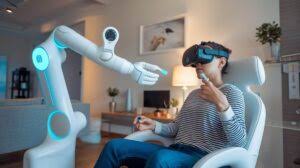In recent years, healthcare has been undergoing a quiet revolution, shifting its focus from hospital-centric models to more personalized, convenient at-home care. Thanks to rapid technological advancements, the future of healthcare is no longer confined to clinical settings. Instead, it’s becoming increasingly accessible from the comfort of one’s own home. This evolution is not just a trend—it’s a necessary transformation that addresses rising healthcare costs, an aging population, and the growing demand for patient-centric care.
The Rise of Smart Home Medical Devices
At the heart of this shift are smart home medical devices. These tools—ranging from blood pressure monitors and glucose meters to more advanced wearable ECG monitors—allow patients to track their health metrics in real-time. Devices are now capable of not only collecting data but also transmitting it directly to healthcare providers via secure digital platforms. This real-time connection ensures early detection of potential issues, timely interventions, and reduced hospital readmissions.
Wearables like smartwatches and fitness trackers have evolved beyond simple step counters. Today’s models can monitor heart rate variability, blood oxygen levels, sleep patterns, and even detect irregular heartbeats. As artificial intelligence (AI) integrates more deeply with these devices, predictive analytics will empower users to proactively manage chronic conditions and make healthier lifestyle choices.
Telemedicine and Virtual Consultations
Telemedicine is another key player in the at-home care revolution. Initially popularized during the COVID-19 pandemic, virtual consultations have proven to be both efficient and effective for a wide range of medical concerns. Patients can now consult with primary care physicians, specialists, and even mental health professionals without stepping outside.
Future telemedicine platforms will likely incorporate augmented reality (AR) and AI to enhance diagnostic accuracy. Imagine a virtual consultation where a physician uses AR to guide a patient through a physical exam or uses AI to review symptoms and provide decision support in real-time.
Remote Patient Monitoring and AI Integration
Remote patient monitoring (RPM) is elevating chronic care management by continuously collecting patient data from home and sending it to providers. Conditions like diabetes, hypertension, and heart disease benefit greatly from RPM, enabling early interventions that can prevent complications.
What’s changing the game even further is the integration of AI and machine learning. These technologies analyze vast amounts of patient data to identify patterns and predict health events. For example, an AI system could alert a healthcare provider if a patient’s blood sugar trends indicate a high risk of hypoglycemia, prompting immediate outreach.
Robotics and Automated Caregiving
For patients requiring physical assistance, robotic technology is advancing rapidly. From robotic exoskeletons that aid mobility to AI-driven personal assistants that remind patients to take medications or perform exercises, these innovations are redefining independence at home.
Additionally, automated medication dispensers and voice-controlled devices are helping individuals with limited mobility maintain a level of self-sufficiency while reducing caregiver burden.
The Role of Interoperability and Data Security
As more devices and platforms enter the home care landscape, interoperability and data security become essential. Future healthcare technology must ensure seamless integration across different systems while safeguarding sensitive patient information. Cloud computing and blockchain are likely to play vital roles in secure data sharing and storage.
Looking Ahead: Personalized, Preventative, and Participatory
The future of at-home healthcare is not just about treating illness but about fostering wellness. With the help of technology, care is becoming more personalized, preventative, and participatory. Patients are no longer passive recipients but active partners in their health journeys.
This shift is empowering individuals to take charge of their health like never before. And while challenges remain—such as digital literacy gaps and regulatory hurdles—the momentum is undeniable.
As healthcare continues to blend with cutting-edge technology, the home is transforming into a high-tech hub for healing and health management, promising a future where care is not just accessible, but also deeply human-centered.



